Related Research Articles

Sir Harry was a British Thoroughbred racehorse and sire. In a career that lasted from May 1798 to August 1801 he ran nineteen times and won nine races. Lightly campaigned in his first two seasons he won Epsom Derby on his racecourse debut and the Claret Stakes at Newmarket in 1799. Sir Harry was much more active in his two remaining years, running fifteen times and winning seven more races including several match races and King's Plates. After his retirement from racing he was exported to the United States where he had a successful record at stud.
Eager was a British Thoroughbred racehorse. In a career that lasted from April 1791 to July 1795 he ran twenty-two times and won ten races. In 1791 he proved himself one of the best British colts of his generation, by winning The Derby and four other races. Eager won a further four races in 1792, but the level of his form declined thereafter and he won only one race in his last three seasons. Towards the end of his racing career he was gelded.
Didelot was a British Thoroughbred racehorse and sire. In a career that lasted from March 1796 to October 1798 he ran ten times and won two races. In 1796 he won a race at Newmarket and then defeated ten opponents, including his more fancied stable companion to win The Derby. His subsequent form was disappointing, as he failed to win in his remaining seven races. At the end of his racing career he was exported to stand at stud in Russia.
Sir Thomas was a British Thoroughbred racehorse. In a career that lasted from October 1787 to May 1790 he ran thirteen or fourteen times and won nine or ten races. In 1788 he became the first horse owned by a member of the British royal family to win The Derby, having been bought as a two-year-old by the Prince of Wales who later became King George IV. Following his win in the Derby, Sir Thomas raced in the Prince's ownership with some success until 1790.
Saltram (1780–1802) was a British Thoroughbred racehorse and sire. In a career that lasted from spring 1783 to May 1785 he ran eight times and won four races. In 1783 he won the fourth running of The Derby on his third racecourse appearance. He won one race in 1784 and was then sold to George, Prince of Wales for whom he won a race at Newmarket in 1785 before being retired to stud. After having some success as a stallion in England he was exported to the United States where he died in 1802.
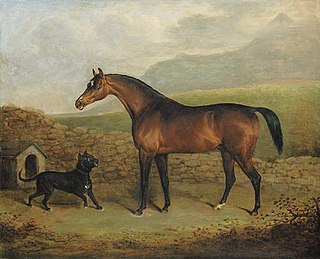
Pope, also known as Waxy Pope and The Sligo Waxy, was a Thoroughbred racehorse that won the 1809 Epsom Derby and was a leading sire in Ireland. Pope was the first Epsom Derby winner produced by his sire Waxy, who would go on to sire three more Derby winners and three winners of The Oaks. Pope was a half-brother to the prolific broodmare Penelope, the dam of the influential stallions Whisker and Whalebone who were also sired by Waxy. Pope died on 29 August 1831 at Clearwell.
Parisot was a Thoroughbred racehorse that won the 1796 Epsom Oaks. Parisot was owned by Sir Frank Standish, who won the 1796 Epsom Derby with his colt Didelot.
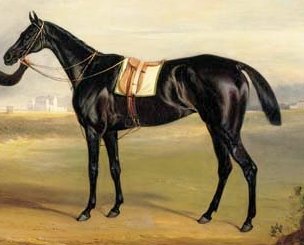
Pussy was a Thoroughbred racehorse that won the 1834 Epsom Oaks. In a racing career that lasted from 1833 until 1837, Pussy started 25 times winning eight races. She initially raced under Thomas Cosby's name and was sold in 1835 to Lord Bentinck but raced under the Duke of Richmond's name. Pussy was retired to Bentinck's stud in 1837 but did not produce any noteworthy offspring. She was sold at auction in 1846, and her last foal was born in 1848.

Grey Momus was a British Thoroughbred racehorse and sire. In a career that lasted from August 1837 to 1839 he competed twenty-one times and won fourteen races. Grey Momus first attracted attention as a two-year-old when he recorded two impressive victories at Goodwood in August. In the following year he won seven times from nine starts, taking two of the year's biggest races, the 2000 Guineas at Newmarket and the Gold Cup at Ascot. Grey Momus won one competitive race and took three walkovers in 1839 before being retired. He was exported to stand as a stallion in Germany, where he had some success as a sire of winners.

Orville (1799–1826) was a British Thoroughbred racehorse and sire. In a racing career which lasted from August 1801 until October 1807 the horse ran thirty-four times and won twenty races. In his early career he was based in Yorkshire and won the classic St Leger Stakes at Doncaster Racecourse as a three-year-old in 1802.

Meteora (1802–1821) was a British Thoroughbred racehorse and broodmare who won the classic Oaks Stakes at Epsom Downs Racecourse in 1805. In a racing career which began with her win in the Oaks on 31 May 1805 and lasted until July 1810 she ran thirty-six timeas and won twenty-four races. She defeated the Derby winner Cardinal Beaufort and the St Leger winner Staveley in match races and won many other important races of the era including the Stamford Gold Cup, the Oatlands Stakes (twice), the Audley End Stakes, the Somerset Stakes and the Brighton Gold Cup. Many of her defeats occurred when she was carrying large weights in handicap races.
Bronze was a British Thoroughbred racehorse and broodmare who won the classic Oaks Stakes at Epsom Downs Racecourse in 1806. Bronze's classic win left her unbeaten in three starts, but her subsequent racing career was undistinguished: in eighteen more races she recorded only three wins, two of which were at relatively minor tracks. After being retired to stud in 1809 she proved to be a highly successful and influential broodmare, whose direct descendants have won many important races up to the present day.
Sorcery was a British Thoroughbred racehorse and broodmare who won the classic Oaks Stakes at Epsom Downs Racecourse in 1811. In a racing career which lasted from April 1811 to July 1814 the filly ran twenty-six times, winning twelve races and finishing placed on eleven occasions. Sorcery won the Oaks on her third racecourse appearance and went on to win other important races including the Epsom Gold Cup, the Trial Stakes, two editions of the Oatlands Stakes, a King's Plate and several match races. After her retirement from racing she became a successful broodmare, being the dam of the 1828 Epsom Derby winner Cadland.

Barefoot (1820–1840) was a British Thoroughbred racehorse and sire best known for winning a chaotic and controversial race for the classic St Leger Stakes in 1823. Bred and originally trained in Yorkshire, Barefoot was beaten on his debut but began a seven race winning sequence when successful in a minor race at Pontefract in September 1822. As a three-year-old he was unbeaten in five starts including the Spring St Leger at York and the Great St Leger at Doncaster. In the latter event, he finished second in a race which was declared void after a false start before winning a re-run. Barefoot was later sold to William Vane, 1st Duke of Cleveland and competed for three further seasons with mixed results, his best efforts being wins in the Lancaster Gold Cups of 1825 and 1826. After his retirement from racing he was exported to the United States where he had limited success as a sire of winners before dying as a result of a snake bite in 1840.
William was a British Thoroughbred racehorse best known for winning the classic St Leger Stakes in 1814. In a racing career which lasted from May 1813 until May 1815 he contested eight races and won four times. After winning his last two starts as a two-year-old, he fell on his first appearance of 1814 and was beaten in his next race before winning the St Leger at odds of 7/1. He was beaten in his only race as a four-year-old and was sold and gelded before returning for two unsuccessful efforts in 1817.
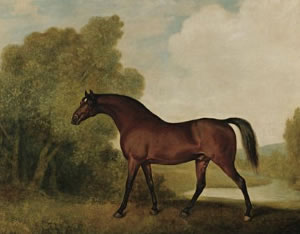
Ambrosio was a British Thoroughbred racehorse and sire best known for winning the classic St Leger Stakes in 1796. In a racing career which lasted from May 1796 until September 1799 he won fifteen of his twenty-three races. As a three-year-old he was based in Yorkshire, where he won his first three races before justifying his position as odds-on favourite for the St Leger, beating six opponents. In the next two years he competed mainly at Newmarket, where his victories three divisions of the Oatlands Stakes and the Jockey Club Plate. He returned to Yorkshire as a six-year-old to win a division of the Great Subscription Purse at York before being retired to stud. Ambrosio stood as a breeding stallion in Great Britain and Ireland, but had little success as a sire of winners.
Beningbrough (1791–1815) was a British Thoroughbred racehorse and sire best known for winning the classic St Leger Stakes in 1794. In a racing career which lasted from May 1794 until August 1797 he won eightof his twelve races. After being beaten on his first appearance, he won his remaining four races as a three-year-old, including the St Leger and the Gold Cup at Doncaster Racecourse in September. He was lightly campaigned thereafter but three times in 1795 and once in 1796. He was then retired to stud where he became a highly successful breeding stallion being the sire and grandsire of many important winners.
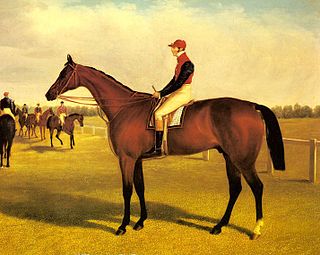
Don John (1835–1857) was a British Thoroughbred racehorse and sire best known for winning the classic St Leger Stakes in 1838. In a racing career which lasted from May 1837 until April 1839 he ran ten times and won nine races, although three of his victories were walkovers when no rival appeared to oppose him. He was one of the leading British two-year-olds of 1837, when his three wins included the Champagne Stakes at Doncaster Racecourse. In the following year he returned to Doncaster where he recorded an emphatic win in the St Leger and then defeated a strong field of older horses in the Doncaster Cup. In the following year he was campaigned at Newmarket where he was beaten for the first time by Grey Momus in the Port Stakes. After one more win he suffered serious leg injuries which ended his racing career. He was retired to stud where he became a successful breeding stallion.
Hephestion was a British Thoroughbred racehorse and best known for winning the classic 2000 Guineas in 1810. The rest of his racing career was undistinguished, as he recorded only four other victories in minor contests from a total of eighteen competitive races. He does not appear to have found a place at stud as a breeding stallion.
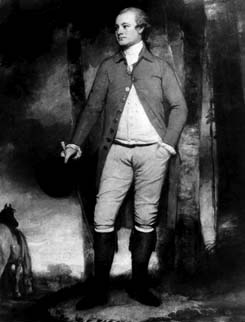
Bridget (1776–1798) was a British Thoroughbred racehorse who won the inaugural running of the Oaks Stakes in 1779. She was bred and owned by Edward Smith-Stanley, 12th Earl of Derby, for whom she produced five foals as a broodmare.
References
- ↑ "Palace House, Newmarket | NHRM, BSAT & RoR".
- ↑ Hunter, Robert J.; Turf Club (Dublin, Ireland). "Racing calendar". Racing Calendar, Containing an Account of Plates, Matches, and Sweepstakes Run for in Ireland.
- ↑ Hunter, Robert J.; Turf Club (Dublin, Ireland). "Racing calendar". Racing Calendar, Containing an Account of Plates, Matches, and Sweepstakes Run for in Ireland.